When at sea, the usage of marine binoculars is required to improve the vessel’s safety. As a mariner, it is essential to understand the binoculars you use at sea in order to guarantee you have the proper one and to update if necessary.
Marine binoculars are more susceptible to damage from the elements than standard ones. Binoculars may also easily tumble off surfaces or out of your hands when sailing in harsh circumstances. Water exposure is also a problem while using binoculars in a sea situation, therefore investing in a water-resistant pair or at the very least water-repellent is highly recommended.
| Marine Binocular | Brand | Our Rating | Check Price on Amazon |
|---|---|---|---|
 | Occer Compact Waterproof Binocular | [su_button url="https://www.amazon.com/Binoculars-Waterproof-Binocular-Traveling-Sightseeing/dp/B0756BXDTX?tag=beka3687-20" target="blank" style="default" background="#E03F00" color="#FFFFFF" size="5" wide="no" center="no" radius="auto" icon="" icon_color="#FFFFFF" text_shadow="none" desc="" onclick="" rel="" title="" id="" class=""]Check Price[/su_button] | |
 | Bushnell H2O Roof Prism Binocular | [su_button url="https://www.amazon.com/Bushnell-Waterproof-Fogproof-Prism-Binocular/dp/B006U3ZIWQ?tag=beka3687-20" target="blank" style="default" background="#E03F00" color="#FFFFFF" size="5" wide="no" center="no" radius="auto" icon="" icon_color="#FFFFFF" text_shadow="none" desc="" onclick="" rel="" title="" id="" class=""]Check Price[/su_button] | |
 | USCAMEL Marine Binocular | [su_button url="https://www.amazon.com/USCAMEL-Binoculars-Rangefinder-Birdwatching-Boating-Army/dp/B016OK3MK4?tag=beka3687-20" target="blank" style="default" background="#E03F00" color="#FFFFFF" size="5" wide="no" center="no" radius="auto" icon="" icon_color="#FFFFFF" text_shadow="none" desc="" onclick="" rel="" title="" id="" class=""]Check Price[/su_button] | |
 | HOOWAY Waterproof Fogproof Binocular | [su_button url="https://www.amazon.com/Waterproof-Fogproof-Binoculars-Rangefinder-Navigation/dp/B01LC3D46A?tag=beka3687-20" target="blank" style="default" background="#E03F00" color="#FFFFFF" size="5" wide="no" center="no" radius="auto" icon="" icon_color="#FFFFFF" text_shadow="none" desc="" onclick="" rel="" title="" id="" class=""]Check Price[/su_button] | |
 | Bushnell Waterproof Binocular | [su_button url="https://www.amazon.com/Bushnell-Water-Proof-Porro-Binocular/dp/B006U3ZJDO?tag=beka3687-20" target="blank" style="default" background="#E03F00" color="#FFFFFF" size="5" wide="no" center="no" radius="auto" icon="" icon_color="#FFFFFF" text_shadow="none" desc="" onclick="" rel="" title="" id="" class=""]Check Price[/su_button] |
What is a Marine Binocular?
It consists of two refracting telescopes positioned side by side and instructed to look in the exact direction, enabling the spectator to view faraway objects with both eyes. The majority of binoculars are developed to be held with both hands, however, measures range from opera glasses to enormous pedestal-mounted military types.
Binoculars deliver users with a three-dimensional vision by presenting a little distinctive appearance to each of the viewer’s eyes, and the parallax helps the visual cortex to construct an experience of depth.
BEST MARINE BINOCULARS – TOP 5 CHOICE
OUR NUMBER 1 CHOICE
[wp-review id=”3410″]
The Runner-Ups
[su_service title=”Bushnell H2O Roof Prism Binocular” icon=”icon: star” icon_color=”#2D3092″ size=”32″ class=””][/su_service]
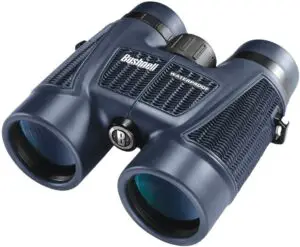
This binocular has high-quality lenses and astonishing HD clarity. It features a beautiful blue color pattern and is made to last. This maritime binocular is completely watertight. For dependable and fog-free functioning, the O ring feature is sealed and nitrogen-purged. Its BaK 4 prisms and multi-coated lenses provide sharp and clear pictures while improving light transmission.
This marine binocular boasts a nonslip rubber armor and a soft texture grip that absorbs shock and gives a secure hold. This binocular features an 8x magnification and a 42-millimeter objective diameter; a close focus distance of 12 feet; and a 17-millimeter eye relief.
[su_service title=”USCAMEL Marine Binocular” icon=”icon: star” icon_color=”#2D3092″ size=”32″ class=””][/su_service]
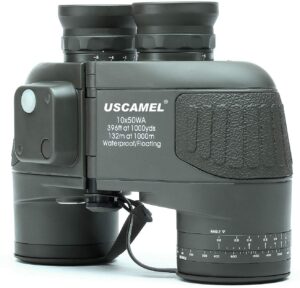
This pair of binoculars has a 10x magnification and a 50mm objective lens. With 5 convex lenses left and right diopter ring, you may change the distance for improved vision without glasses and precise focusing. The eyecups are readily foldable, allowing you to use them while wearing glasses.
The BAK4 Prism’s high refractive index minimizes stray light and improves shade reproduction. The green FMC layer minimizes mirrored light in the objective lens while increasing glow transmission, picture illumination, and image bite.
It contains a Night vision function with an illuminated compass built-in for guidance locating, as well as an integrated rangefinder for calculating the distance and size of the object instantly on the left eyepiece.
[su_service title=”HOOWAY Waterproof Fogproof Binocular” icon=”icon: star” icon_color=”#2D3092″ size=”32″ class=””][/su_service]
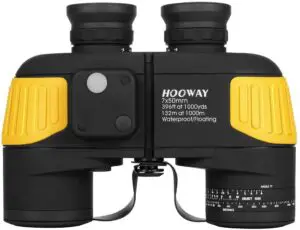
This Marine binocular has a 7x magnification and a 50mm objective lens, as well as 22 mm eye relief with a 6.8mm exit pupil, and a field of vision of 396 feet at 1000 yards / 132 meters at 1000 meters. It is capable of adapting to harsh environments.
This product is completely waterproof and floats in water. Nitrogen-purged fog proofing is Stable, pleasant to handle, and long-lasting. It has a Porro prism system for a broad field of view. Bright, neat pictures are made by the premium BAK4 prism and fully multi-coated lenses.
It has an Illuminated Compass for identifying the direction and size of things, as well as an inbuilt rangefinder for estimating the distance and size of objects. It contains non-slip rubber protection that absorbs shock and gives a strong grip for more comfortable use.
[su_service title=”Bushnell Waterproof Binocular” icon=”icon: star” icon_color=”#2D3092″ size=”32″ class=””][/su_service]
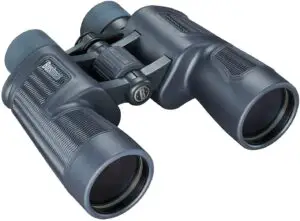
This maritime binocular is waterproof and anti-fog, and it is O-ring sealed, so it can tolerate being dropped in standing water. They’ve also been nitrogen cleansed to get rid of any inside dampness and avoid fogging.
These binoculars are feature-rich but simple to use, featuring a wide central focus knob that allows you to sharpen image quality with a single turn. Twist-up eyecups allow fast viewing and allow the binoculars to be easily adjusted for persons who use spectacles.
Bushnell H2O Waterproof/Fog-Proof Compact Binoculars improve light transmission and produce clear, bright pictures thanks to multi-coated (MC) lenses and superior BaK-4 prisms. Bushnell is the most known and trusted sports optics brand in the world, blending cutting-edge design and performance with a dedication to being accessible to all.
Qualities to look for When Buying Marine Binoculars
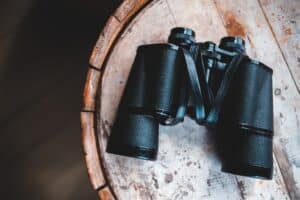
➖The Type of Prism
Porro prisms are said to be more technically preferable to roof prisms. Binoculars with Porro prisms can fit a scope finder or compass more readily. Look for those that are composed of BAK-4 optical glass.
➖The Magnification
This is the first of two numbers that describe a pair of binoculars. A “7x” value indicates that the item will look seven times closer than it would with the naked eye. Since boats are rarely steady, 7x is the best setting.
➖The Objective Lens
This is the second of two numbers that describe a pair of binoculars. A “50” indicates that the lens is 50 mm in diameter. The bigger the lens, the greater the eyesight in low light; nevertheless, the larger the binoculars. A 50 mm lens strikes an appropriate balance between light gathering and weight.
➖The Exit Pupil
The exit pupil is a role of magnification and factual lens diameter that specifies the quantity of light that enters your eyes. The exit pupil of a 750 pair of binoculars is around 7.1 mm, which is similar to the pupil size of a dark-adapted human eye. As a result, the 750 will not restrict accessible light.
➖Waterproof Feature
Even if the binocs are never dropped, this function keeps water vapor out and prevents fogged lenses. There is no standard for “waterproof” claims: military specifications call for a depth of submersion of 16 feet.
➖The Focus Mechanism
Individual focusing allows you to adjust for each eye. With center focusing, just the center knob has to be adjusted. Individual concentrating improves waterproofing qualities.
➖The Lens Coating
Look for binoculars with fully multicoated (FMC) lenses for maritime use.
➖The Field of View
The visibility of the seascape in degrees. The greater the number, the greater the field of vision visible via the binoculars.
➖Fog Resistance Feature
Look for binoculars loaded with nitrogen, a gas that does not develop in response to temperature variations. When air-filled binoculars are left in the sun, the internal pressure can build-up to the point where a seal is broken, allowing damp air to enter the binoculars.
➖The Grip
A softer grip soaks shocks and prevents the binocs from slipping off the helm or table.
➖Eye Relief
The maximum space from the eyepiece at which you can see the whole area of vision of a binocular is referred to as eye relief. Lengthy eye relief of roughly 25 mm is ideal if you wear glasses or sunglasses.
➖The Eye Cups
Eyecups — some with exterior “wings” — that go over the eyepieces help to improve your visibility by blocking off peripheral light. When wearing glasses, the eyecups must be folded back.
➖Foldable Feature
If you’re often on the run with your binoculars, you might consider investing in an excellent pair of folding binoculars. Binos, particularly Porro prism type sets, may be huge and clumsy. A set of folding binoculars, on the other hand, can aid to reduce cumbersome transport.
Changing the Eyecups and Barrels in a Binocular

????Step 1
Set the gap between the barrels of the binoculars. Hold the barrels with your hands and squeeze them inside toward one other to close the gap. Draw them away from each other in the other direction to increase the gap.
Continue to adjust the barrel distance until your vision is a complete circle. If you notice black outlines in your range of view, the barrels are too far apart; squeeze them together to close the gap.
????Step 2
Retract your eyecups to have a better field of vision. If you’re going to be staring at a broad, open region or focusing on an object at the edge of your view, fully retract your eyecups by pressing them all the way down to the barrels.
This stance is especially ideal for folks with deep-set eyes since it allows you to rest the retracting cups on your pronounced brows. Since this position is more vulnerable to the outdoors, keep a close eye out for dirt and dust.
????Step 3
Extend your eyecups to get a better perspective. Advancing your eyecups fully brings your eye nearer to the optic lenses, eliminates peripheral light, and shields the lenses from dirt and dust. Pull them as far apart from the barrels as feasible to lengthen them.
Although it narrows your field of view, it is the greatest option for taking a close look at a single item in the center of your view.
????Step 4
For the best flexibility, keep your eyecups in the central position. The middle eyecup setting is great if you’ll be heading somewhere with a range of sights and circumstances.
It will provide a decent field of view, intercept off a significant amount of peripheral light, and shield the ocular lens from dirt and dust.
Diopter Adjustment in a Binocular
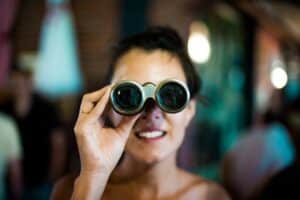
????Step 1
Locate your binoculars’ diopter adjustment. A diopter is a unit of focusing power, and many lenses feature a diopter adjustment on a single lens that allows you to compensate if one of your eyes isn’t seeing as well as the other.
The diopter scale is marked “+” on one side and “-” on the other. Others have the diopter adapting on the left eyepiece.
????Step 2
Focus your lens on the non-diopter side. First, locate a remote object with a lot of elements, such as a tree. Once you’ve done that, come to a halt and shield the lens with the diopter settings, either with your hand or a lens cover. Turn the center guide wheel until you can view the thing as well as possible.
????Step 3
On the other lens, change the diopter setting. Place your palm or lens cover on the objective lens that you just focussed on. Now, using your other eye, concentrate on the object again with the diopter glass.
Change the diopter until the tree’s features are as crisp and clear as possible. While adjusting the diopter, do not modify the center focus wheel.
????Step 4
Examine the clarity by looking through two lenses at the same time.
If the picture is still blurry, repeat the process until it is clear. The final image you see via your binoculars should appear three-dimensional. If you have eye discomfort, the binoculars may be out of sync. If the modifications don’t work, contact your manufacturer.
Several Types of Binoculars
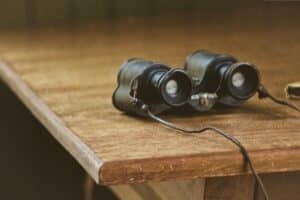
You’ll need to do some research even when you’re a first-time buyer or skimming for your next pair of binoculars. There are many different types of binoculars, and knowing what’s available is the first step in selecting the right one.
⚫The Roof Prism Binoculars
When it comes to current binocular styles, there are two primary categories: roof prism and Porro prism. They’re more streamlined, straight-tubed, lightweight, and compact than traditional Porro prism binoculars.
While they appear simple on the surface, this form of binocular features a far more complicated machination than any other style.
Roof prism binoculars can really generate far greater magnification power and brighter end images when used in this sequence.
⚫The Porro Prism Binoculars
Porro prism binoculars are the second most common form of binocular. These are the original style of binoculars. The Porro prism idea functions by delivering rays from your factual lenses in a rapid horizontal jag via an interdependent pair of triangular light-catchers.
This motion then amplifies and inverts the light, providing you with a clear, enlarged view of your subject. The zigzag shape makes the binoculars a little heavier and awkward than the roof prism type. However, this design technique has several advantages.
Porro binoculars frequently produce a crisper, three-dimensional image than roof prisms. Furthermore, they typically have a larger area of view than straight-tubed roof-style binos. And they’re really simpler in design and, as a result, far less expensive to manufacture.
⚫The Night Vision Binoculars
A typical pair of binoculars will be worthless to you if you require them at night or in low-light conditions. In these examples, you may want to ponder investing in a set of night vision binoculars.
After this procedure, your eyes are provided with useful images to assist you in navigating the dark.
⚫The Marine Binoculars
Marine binoculars are a type of binocular that is specifically built for use in and around water. They have a larger ocular and objective lens, as well as low to moderate magnification power. When you’re on the high seas, you’ll want something with a bigger field of vision and lower magnification.
When the magnification is too high, even the tiniest hand movement will result in a wobbly image. Think how challenging it would be to maintain balance on a rolling boat. In addition, marine binoculars are usually fog-free and waterproof.
And, relying on the model, they may be just as valuable beneath the waves as they are above.
⚫The Astronomy Binoculars
If you’re a stargazer or an amateur astronomer, you’ll want a set of binoculars made exclusively for exploring the cosmos. A telescope is excellent, but there are instances when one isn’t available or practicable.
Some are small enough to fit in your pocket for on-the-fly viewing. Some even require a tripod, comparable to that of a telescope. These bigger versions are more expensive and bulky, but their two ocular lenses provide a significantly wider field of vision than a conventional telescope.
⚫The Opera Glasses
Binoculars are perhaps the last thing that comes to mind when you think of them. However, they have been around nearly as long as contemporary binoculars. And, to be honest, they’re usually the most fashionable sets available.
These are used to see theater shows and musical performances. It might be tough to pick up on all of the subtleties that performers and musicians put into their work. However, these specially built binoculars will assist you in detecting even the most delicate motions.
The Benefits of using a Binocular
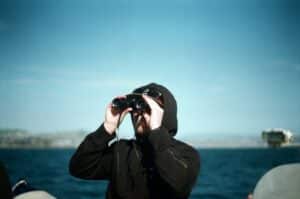
✔️There is a Greater Sense of Depth
When the eyes of a species with the binocular image are in front of and close to each other, the appearance of depth is greatly improved.
✔️There is Adaptability
Another advantage of having two eyes that can instantly focus on vision is the ability to utilize only one eye if the other is damaged or impaired.
Although it may be difficult at first and requires adjustment, having only one functional eye is viable.
✔️3D Vision is Possible
People with binocular vision have their eyes in front of them and can use both to concentrate on a picture. The eyes are also only a few inches apart, allowing them to view two separate pictures while the brain processes the two images as one. This enables users to see movies in 3D.
Frequently Asked Questions
Q: What are the applications of marine binoculars?
A: In reality, any binocular, regardless of size, features, or power, may be used on the sea.
Q: How do marine binoculars function?
A: Binoculars steady the image by continually compensating for the mobility of the device in your hands by moving the lenses.
Q: What kind of binoculars do the Navy Seals use?
A: Both the Army and the Marine Corps use the M22 binocular as their primary field binocular.
Q: Can binoculars work underwater?
A: Binoculars are not suitable for usage in water. Even if your models are waterproof, wipe off any rain, dew, or mist with a dry cloth before storing them.
Q: How do you remove condensation out of binoculars?
A: Place the binoculars in a warm, dry location for a few days. Because most binoculars are not airtight, any moisture within should drain into the dry air outside.
Final Thoughts
There are several high-quality marine binoculars on the market. It might be difficult to select the best one for you. The goods listed above are among the best on the market. It is critical to conduct your own research in order to choose what is best for you. It is also critical to understand how to use them correctly.
